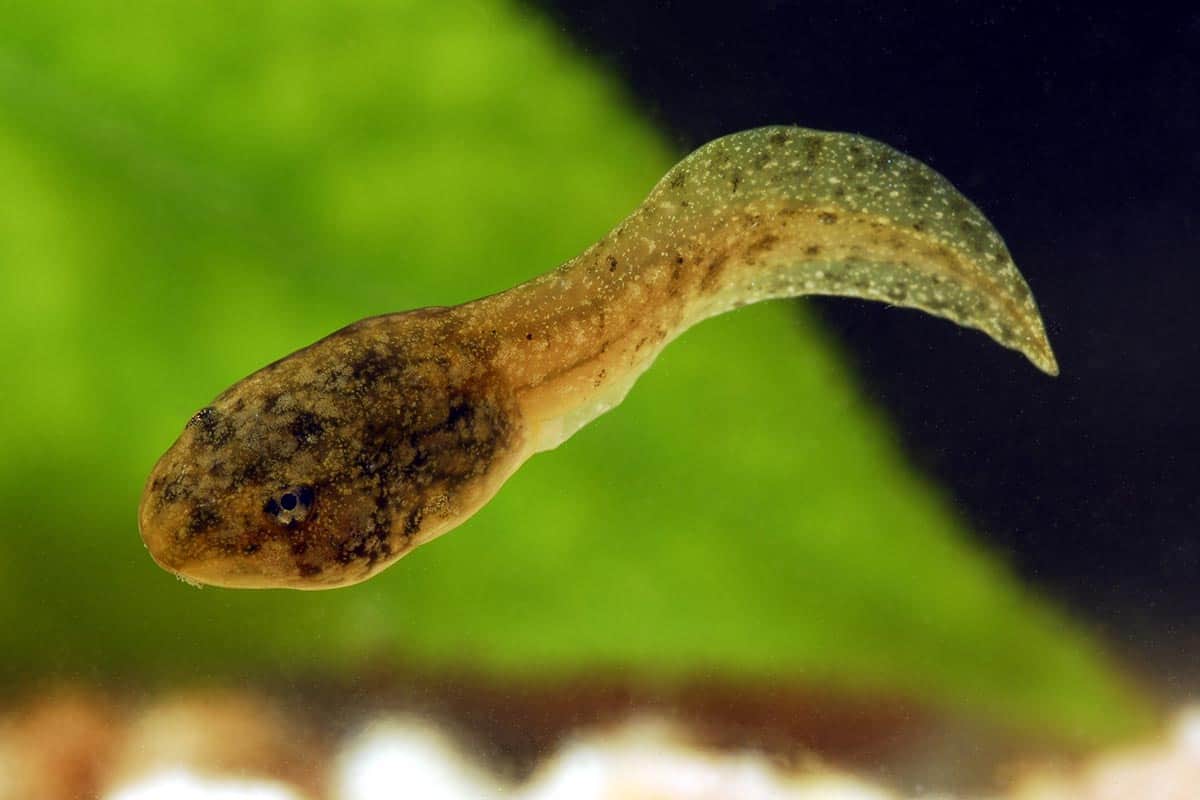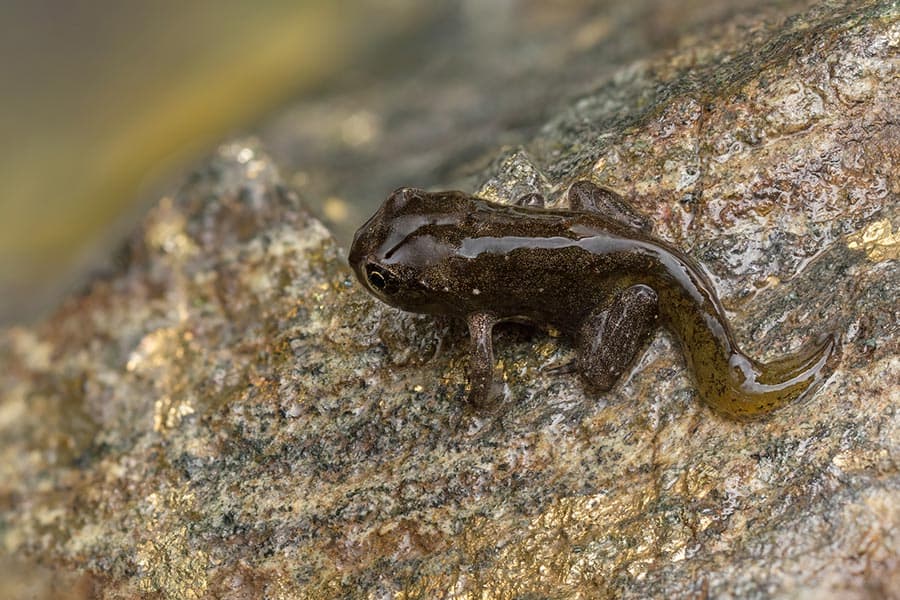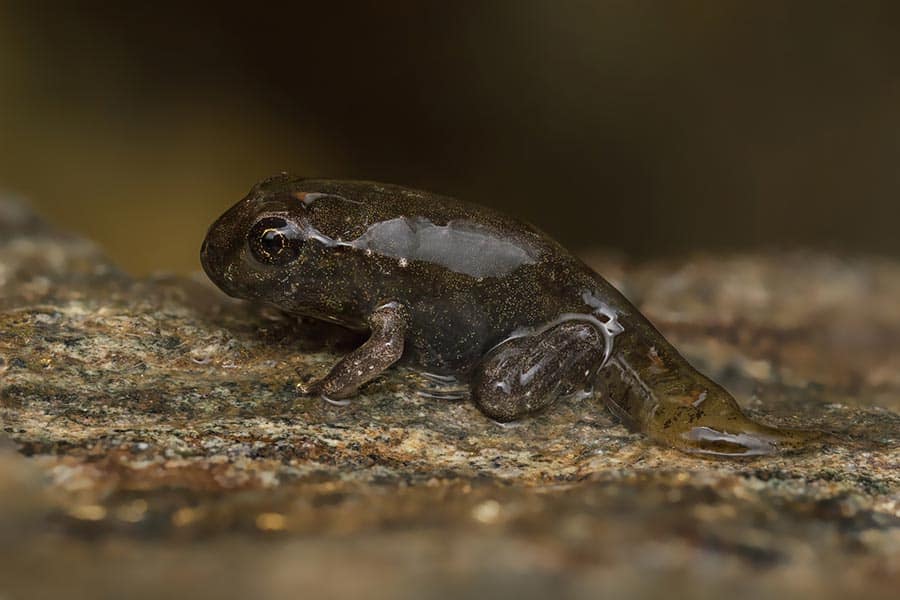
Tadpoles are the baby form of frogs when they hatch from their eggs. You can keep tadpoles and watch the fascinating process of them growing into frogs! If you are raising one, knowing what tadpoles eat is important so you can help them grow into healthy adult frogs.
What Do Tadpoles Eat? They mainly consume plant-based foods to fuel their growth. We recommend offering a variety of options to ensure their nutritional requirements are met.
Tadpoles are very different from their adult frog counterparts. Adult frogs are completely carnivorous. Tadpoles, however, are completely vegetarian when they hatch! Their digestive tracts are long, winding, and specially designed to process plant matter. Longer digestive systems provide the body with time to break down and extract nutrients in plant matter.
As the tadpoles develop and grow, their digestive systems shorten and are suited to a carnivorous diet. This means you will have to adapt their diet as they grow.
Read on to find out what tadpoles eat in the wild and how you can best replicate that in captivity!
What Do Tadpoles Eat in the Wild?
In the wild, tadpoles are opportunistic feeders, which means they will eat almost anything they can get into their mouths. Unfortunately, this means we are not 100% sure about everything that they eat. However, through scientific study, we have figured out the basics.
Tadpoles stay in the place where they hatched for most of their development before they grow legs and start moving between neighboring water sources. When they are very young, the tadpoles will mainly feed off of algae that are growing in their surroundings.
As they develop, the tadpoles will start moving around more. They also have large mouths with stronger jaws. At this stage, they will start eating insect larvae they can find in the water as well as phytoplankton.
As they grow a little more and their mouths grow a little larger, they will start eating the nymph forms of insects as well as other very small aquatic organisms such as small snails and shrimp-type animals.
Feeding Captive Tadpoles
Captive tadpoles should be fed a diet that mimics their natural one as closely as possible. During their cycle as tadpoles, these animals require a massive amount of energy and food in order to grow and develop properly.

This is a general guide to feeding tadpoles. Certain species will require additional nutrients or follow a slightly different timeline in terms of changing their diet.
You should always research the specific type of tadpole you have and determine its species as soon as possible. It is nearly impossible to distinguish tadpoles from one another in terms of species, so if you are not sure what species you have, follow this general guide.
Feeding Freshly-Hatched Tadpoles
As tadpoles hatch, they will feed off the yolk of their egg. This yolk is very high in important nutrients, and it is essential that your tadpoles finish eating this yolk before they are moved or the tank is cleaned.
Once they have eaten the yolk, freshly hatched tadpoles will live solely off of algae. Algae can be found in their enclosure on things like hides, substrate, plant life, and other decorations.
However, you can also drop algae tablets into their tank for them to feed on. They should get one to two tablets (depending on how many tadpoles you have in the enclosure) to feed on twice a day.
It is essential that you remove any uneaten tablets after an hour to avoid turning the water toxic and having an algae problem.
Freshly hatched tadpoles will also eat duckweed and nibble on lily pads. Having duckweed and lily pads in their enclosure will help your tadpoles feed throughout the day without worrying about fouling the water with decomposing food.
Feeding 1- to 2-Week Old Tadpoles
One to two-week-old tadpoles now need additional food in their diet. They are growing rapidly during this stage and need lots of food to fuel their growth.
You can feed your tadpoles a series of greens that are rich in
However, it is always better when the
Acceptable greens to feed your tadpoles are:
- Collard greens
- Dark lettuces
- Broccoli
These items should float on the water. The tadpoles will surround the edges of the greens and nibble on them. Always make sure the greens you are providing them with are younger and tender. If they are too thick or fibrous, then your tadpoles will not be able to eat them.
In addition to greens, you can start introducing some sources of protein. These can be commercially-made frog and tadpole pellets, algae rounds that include protein sources, and even commercial fish food flakes.
If you’re iffy about buying ready-made food, here’s a recipe you can make for your tadpole.
It is important to keep a careful eye on how much you are feeding your tadpoles at this stage. They should have voracious appetites. However, if there is any food left in the enclosure, it will start to decompose and change the pH balance of the water and turn it toxic.
Feeding 2 to 4 Week Old Tadpoles
When tadpoles are two to four weeks old, they need a significant increase in the amount of protein they are getting. At this stage, their digestive system is shortening and straightening out and becoming more suited to a carnivorous diet. At this stage, you should decrease the number of pellets, flakes, or plant food that you are feeding them and increase the amount of protein.

At this stage, you can start to feed them insect larvae such as mosquito larvae. These larvae are still small enough for their mouthparts; however, they are packed with protein.
You can feed your tadpole things like:
- Aphids
- Brine shrimp
- Bloodworms
- Tubifex
- Blackworms
- Chopped up nightcrawlers
- Fruit flies
At the end of the four weeks, you will be able to transition them to their completely carnivorous diet and cut out any and all plant matter.
If you run into a problem with feeding your old tadpoles and younger frogs insects or worms, then you can use the frog pellets. However, these should not form the basis of your frog’s diet, as they need the nutritional variety provided through fresh food.
FAQs About Feeding Tadpoles
How often should I feed my tadpole?
This depends on how old they are. Hatchlings should be fed twice a day, and uneaten food should be removed after an hour.
Older tadpoles should be fed a large meal once a day. However, they should not be overfed. After two hours, check the tank for uneaten food and remove any before it starts to decompose and foul the tank water.
Once they are fully developed as frogs and have lost their tails, you can switch over to their feeding schedule that they will follow as frogs for their specific species.
Are tadpoles completely aquatic?
Tadpoles are the larval stage of a frog’s life cycle. At this stage, they are all aquatic. However, as soon as you see their legs start to develop, you should provide them with a bit of terrestrial land inside their enclosure so that they can start moving between land and the water.
If they are moving between the land and the water, you can start introducing them to terrestrial forms of food such as crickets and aphids!
How do I care for the wild tadpoles in my outdoor pond?
You should not need to feed the tadpoles in your outdoor pond. Your pond will have plenty of algae in it for them to feed off of as newly hatched tadpoles. As they get older, they will eat the insect larvae that have been laid on the pond’s surface.
It is important to not chemically treat your pond if you want your tadpoles to thrive. Chemically treating your pond will prevent algae growth and kill off any tadpoles that are already in it.
Conclusion
Tadpole care is very simple. They require very little energy from you and can live in a wide range of water conditions. Their food needs are easy to meet if you have the basics at hand. So, what do tadpoles eat? Well, anything they can fit in their mouths.
Tadpoles eat a range of food, starting off as herbivores and progressing to omnivores before fully transitioning into their final carnivorous frog form. A decent amount of algae will be eaten in the tank if you have allowed it to grow, and your tadpole will move on to some greens, larvae, and finally to little animals like brine shrimp and tubifex.
Always remember to provide your tadpole with variety to ensure they are getting all of their nutritional needs met so they can grow into a strong, healthy frog!

